Preparations in Kayar and Dakar, Senegal
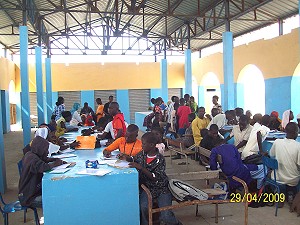 The Principal of the College (CEM) in Kayar, Mr. Abibou Diop, with the support of Aliou Sall, researcher in the ECOST Project and Head of the local NGO CREDITIP, has pursued efforts to develop relations with European schools and strengthening of art work in his school around the issues of sustainable seas and general education.
The Principal of the College (CEM) in Kayar, Mr. Abibou Diop, with the support of Aliou Sall, researcher in the ECOST Project and Head of the local NGO CREDITIP, has pursued efforts to develop relations with European schools and strengthening of art work in his school around the issues of sustainable seas and general education.
Dr. Sall, with his many connections to traditional fishing communities in Senegal, has also obtained collaboration from the artist and photographer in Saint Louis, Alboury Ndiaye as well as continued support of Dakar-based artist and sculptor, Samba Laye Diop.
As far as the specific stages of preparations in Kayar are concerned, it is useful to know about the methodology adopted before getting to the actual realisation of art works. Infact, the preparations went through the following process:
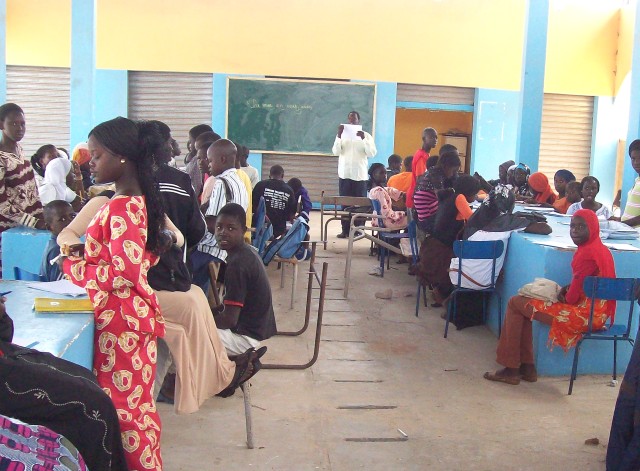
1. At the onset, there was a first meeting, in April 2009, in the premises of the Departmental Fisheries Service, that is the public institution representing the Ministry of Maritime Economy and International Maritime Transport, Marine Fisheries Directorate, at the level of the Thiès Region, in which the town of Kayar is located. The twin objectives of the meeting were:
a) To establish a synergy with the administrative services representing the central authorities (the Senegalese State) at local level in Kayar by getting them interested in the project by way of simple incentives to become active in the undertaking not only for Amsterdam, but also in a longer-term perspective;
b) To allow the teachers and students of the school in Kayar to better familiarise themselves with the concept of 'sustainable development' and its translation into practice. For this reason, the following persons with a confirmed expertise in fisheries have been invited to intervene:
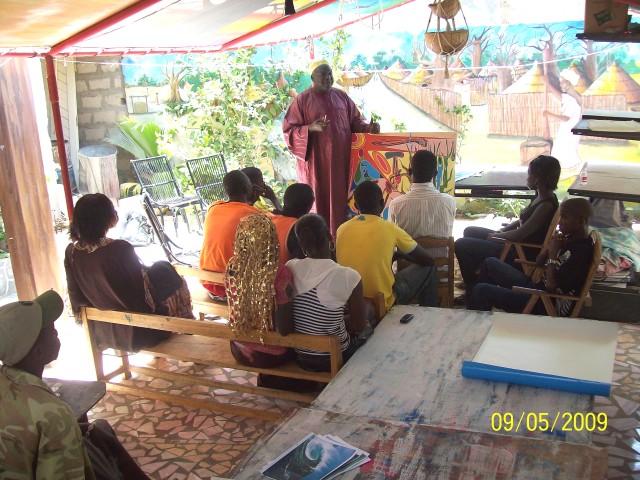 Dr Issa MBENGUE: Fisheries Service Chief of the Thiès Region,
Dr Issa MBENGUE: Fisheries Service Chief of the Thiès Region,- Colonel Abdoulaye DIOP: Park ranger of the Marine Protected Area in Kayar,
- Two teachers of life sciences and science of the earth of the CEM Kayar, namely Ms. Fatoumata SOUMARE and Mr. Mamadou DIOUF.
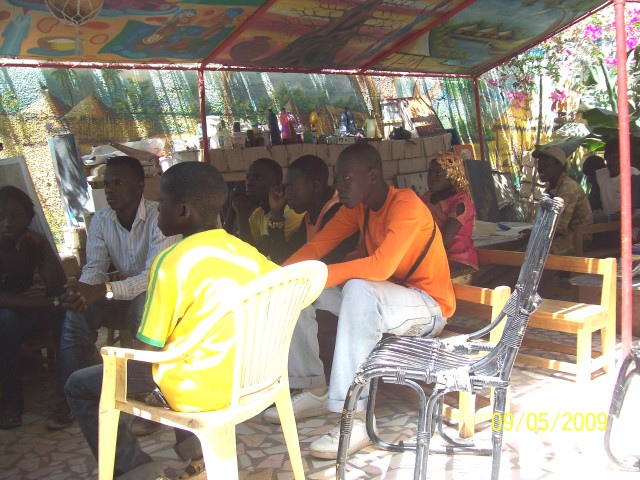 2. The second stage consisted of imparting more arts lessons to the students of the CEM Kayar in the large hall near the beach, which normally serves to handle freshly landed fish. This hall had been occupied by the CEM Kayar out of lack of suitable own rooms at the school itself. The best performers have been invited to a course in May in the arts village in Dakar.
2. The second stage consisted of imparting more arts lessons to the students of the CEM Kayar in the large hall near the beach, which normally serves to handle freshly landed fish. This hall had been occupied by the CEM Kayar out of lack of suitable own rooms at the school itself. The best performers have been invited to a course in May in the arts village in Dakar.
3. The third phase involved to go to the artist Abdoulaye Seck for the actual realisation of new paintings. The session called artistic creation was preceded for methodological reasons by a series of questions and answers animated by the artist himself. This session helped the pupils to articulate their 'project of expression'. It is after this initial exercise that the students implemented their projects along the lines of the following themes:
-
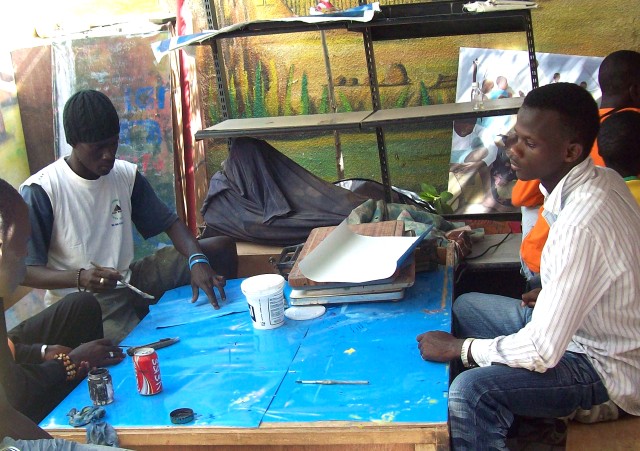 The monofilament gillnet against which the village of Kayar fights since several years given its negative effects on the marine environment of this fishing method,
The monofilament gillnet against which the village of Kayar fights since several years given its negative effects on the marine environment of this fishing method, -
The clandestine emigration on pirogues which, in the last years provoked hundreds of fatalities (of young people) among those wanting to reach the Canary Islands from Kayar and other beaches by boat,
-
The pollution and decline of marine and coastal resources due to the combined effects of natural climate effects and human intervention,
-
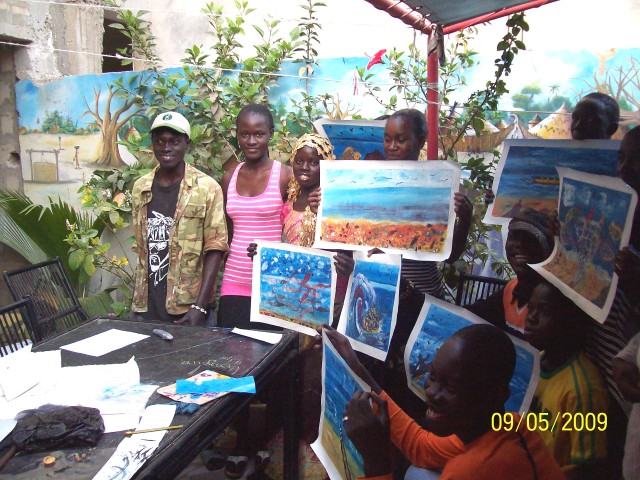 The swell and its crossing, which is a point of honour for the fishermen who have to demonstrate day after day their courage and skill associated with the maritime occupations of the Kayar fishermen,
The swell and its crossing, which is a point of honour for the fishermen who have to demonstrate day after day their courage and skill associated with the maritime occupations of the Kayar fishermen, -
The vistas of the village showing the panorama of Kayar and the beauty of the place of which the youngsters are proud.
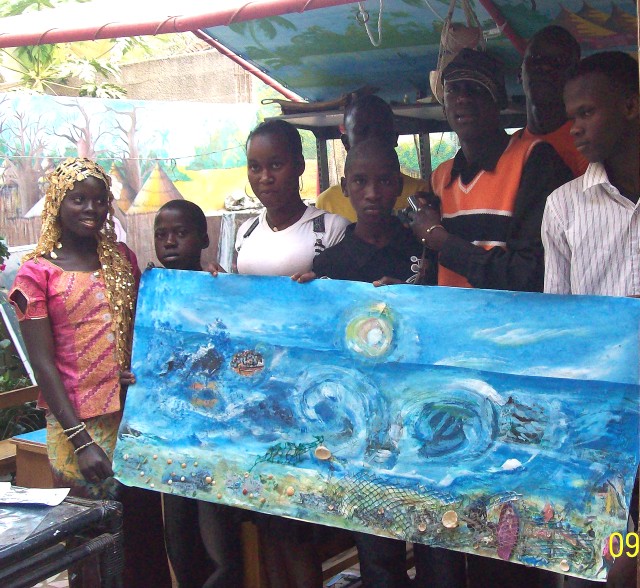 This foremost fishing town in Senegal is at a turning point, because the decline of resources, mostly as a result of overfishing, in combination with demographic and other pressures is threatening its future.
This foremost fishing town in Senegal is at a turning point, because the decline of resources, mostly as a result of overfishing, in combination with demographic and other pressures is threatening its future.
The WWF webpage on Kayar summarises some of the issues. It is in this context that the young people grow up and produce the works on display in the exhibition (see also the link to the documentary - 'Cry Sea' in the Kayar Section).








